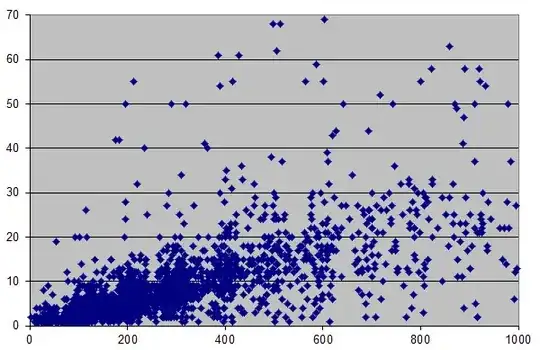I have a following data-set:
> data$R
[1] 0.70 0.75 0.80 0.85 0.90 0.95 1.00 1.05 1.10 1.15 1.20 1.25 1.30 1.35 1.40
[16] 1.45 1.50 1.55 1.60 1.65 1.70 1.75 1.80 1.85 1.90 1.95 2.00 2.05 2.10 2.15
[31] 2.20 2.25 2.30 2.35 2.40 2.45 2.50 2.60 2.65 2.70 2.75 2.80 2.85 2.90 2.95
[46] 3.00 3.05 3.10 3.15 3.20 3.25 3.30 3.35 3.40 3.45 3.50 3.55 3.60 3.65 3.70
[61] 3.75 3.80 3.85 3.90 3.95 4.00 4.05 4.10 4.15 4.20 4.25 4.30 4.35 4.40 4.45
[76] 4.50 4.55 4.90 4.95
> data$MRCI8
[1] 69.10108 56.65276 47.82651 41.64975 37.41315 33.68440 31.29635 29.75257
[9] 28.87221 28.34471 27.71358 26.05035 24.95444 24.03100 23.29969 22.71869
[17] 22.25380 21.87805 21.56874 21.30299 21.01756 20.61259 20.22289 19.88496
[25] 19.59455 19.34637 19.11511 18.94022 18.79525 18.67703 18.58289 18.51252
[33] 18.45438 18.41333 18.38730 18.37395 18.37071 18.38427 18.39670 18.41077
[41] 18.42544 18.44003 18.45415 18.46754 18.48009 18.49176 18.50254 18.51246
[49] 18.52155 18.52988 18.53748 18.54440 18.55068 18.55633 18.56108 18.59038
[57] 18.59568 18.60022 18.60429 18.60789 18.61100 18.61363 18.61581 18.61763
[65] 18.61914 18.62043 18.62155 18.62256 18.62349 18.62436 18.62520 18.62602
[73] 18.62682 18.62761 18.62839 18.62915 18.62990 18.67205 18.67038
Now, I need to fit the data and to get the equation describing the line.
1) I know, I can fit the points using smooth.spline, but I have no idea, if it's possible to get the equation as $y(x) = c_0 + c_1x + c_2x^2\ldots$
2) If it's not possible, then I'd like to fit the data with Lennard-Jones potential, i.e. with the formula
$$ V_{LJ}(r) = 4\varepsilon\left( \left( \frac{\sigma}{r} \right)^{12} - \left( \frac{\sigma}{r} \right)^6 \right)$$, where $\varepsilon$ and $\sigma$ are the parameters to be fitted.
Could you, please, advise me, how to do any of these things?
